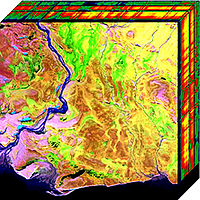
Photo from wikipedia
Laser cleaning of stones is a well-established technique in conservation of Cultural Heritage. In case of polymineralic granular rocks like granite, the tuning of the laser parameters for safe cleaning… Click to show full abstract
Laser cleaning of stones is a well-established technique in conservation of Cultural Heritage. In case of polymineralic granular rocks like granite, the tuning of the laser parameters for safe cleaning becomes a demanding task due to the differential response of the constituent minerals to laser irradiation. In this sense, a compromise solution must be reached between removing unwanted layers and safeguarding the original characteristics of the stone substrate. Consequently, the need of non-invasive, rapid and accurate methods for in situ identification of the minerals in the stone surface is highlighted. The aim of this paper is to demonstrate the ability of a laboratory scale hyperspectral reflectance imaging system, in combination with artificial neural networks for in situ, accurate identification of constituent minerals of a hercynian granite; with the ultimate goal of achieving automatic adjustment of laser irradiation parameters in cleaning processes. The effectiveness of a neural network with the structure of a three-layer perceptron was evaluated by comparing calculated results with modal analysis composition obtained by petrographic microscope and a high degree of accordance, above 95%, was achieved.
Journal Title: Journal of Nondestructive Evaluation
Year Published: 2017
Link to full text (if available)
Share on Social Media: Sign Up to like & get
recommendations!